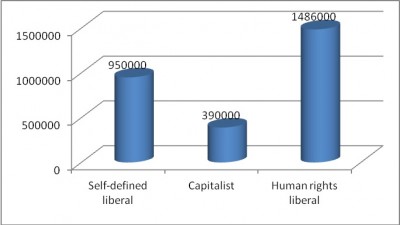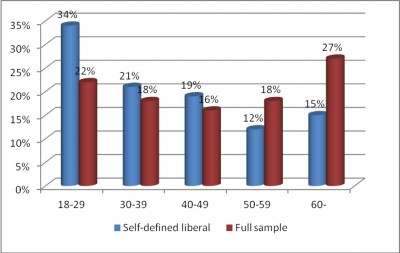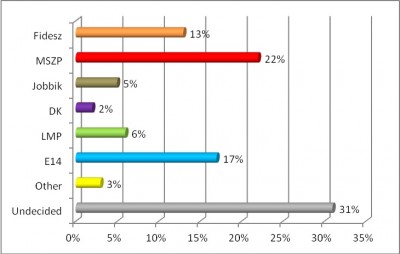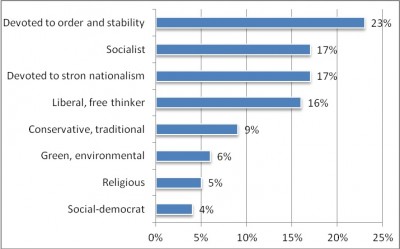Project Parallel liberalisms, based on research by Republikon Institute, aims to define liberal voters of Hungary – who these liberal voters are and where they stand. Today it is a valid question, since recently the number of parties trying to reach liberal voters multiplied – although there is no general knowledge about the number of these voters, nor of their political attitudes. The study uses an easy method to distinguish liberal voters and divides them into three categories. After recognizing the liberal electorate, it estimates if their party preference adjusts to the liberal values – since Hungary currently lacks a party which identifies itself with the universal liberal values (SZDSZ dropped out of parliament in 2010). The study shows whether they support the current, conservative Fidesz government or not – and if not – which parties they prefer, the radical right-wing Jobbik, the biggest opposition party, the socialist MSZP, or other formations of the left-wing or centrist opposition – DK, LMP, Együtt2014. But most importantly, the study identifies three categories of liberalism and their socio-demographic and political attributes: the self-defining group, a younger, well-educated, well-earning class with heterogeneous party preferences, but in favor of changing the government; the capitalists – an older, metropolitan, highly educated group with strong leftist political preferences; and the human rights liberals, whose main attributes coexist with political personalities not compatible with liberalism.
To find the liberal voters, one may follow two paths – one is self-definition, creating a group of voters that call themselves liberal. These voters have to choose from eight different political characters (for example social democrats or religious people) the one describing their personality best and they chose the „liberal, free thinker.” 12% of the sample chose this answer in the survey, thus every 1 out of 9 Hungarians defines themselves as liberal. Even so, this self-definition does not always come with a coherent political thinking. The research casts light on the fact that people calling themselves liberal are not unified – neither in their chosen party, nor in policy questions, that is, they wouldn’t always choose a liberal solution.
The other option – defining liberal voters – is to interpret their answers given in policy questions. In this case, a liberal voter is someone choosing the liberal answer in the majority of the questions. During the survey, this liberal group was divided into two fundamentally differing sub-groups. One is the free-market liberal, the „capitalist” group, which, in an economic policy questionnaire chose the liberal option (for example the acceptance of a tuition fee in higher education or supporting integration of foreign capital) at least 5 times out of 8. 4% of the answers were put into this category. The other sub-group was named the human rights-liberal group, with the respondents choosing the liberal attitude at least 4 out of 6 times in questions about choosing between values. These topics included the separation of state and church, the current state of Roma community or defending rights and dignity of criminals. 18% of the respondents were ranked into the human rights liberal category, creating the widest addressable liberal group of voters.
1. Figure: Rate of liberal categories projected to total population
Comparing these categories, one can conclude that these are well-separated pieces of the population. There is very little overlap between the categories, only 4.5% can be ranked into more than one liberal category. Less than 1% of the sample is present in all three categories, while about 30% of the entire population is part of at least one liberal group.
The number of liberals among the population was projected on the electorate of the 2006 SZDSZ. The results speak for themselves: the number of self-defined and human rights liberals exceeds that of any current party, and human rights liberals measured in the entire population were present in SZDSZ four and half times more.
2. Figure: Rate of liberal categories among 2006 SZDSZ voters
The question arises if there will be a political formation able to dip from the parallel liberal groups scattered after the fall of SZDSZ. Since both self-defined and human rights liberals are very heterogeneous, collecting all categories into one party seems highly unlikely.
The survey shows that a self-defined liberal is more educated and younger than the national average. More than one-third of them are below 30 years old, another one-fifth is less than 40 years old. They beat the average in people with at least a secondary education. 54% of those interviewed are searching for jobs, and the ones with a current workplace earn higher wages – more than the average, which defines themselves to the middle- and upper middle classes.
3. Figure: Self-defined liberals distributed to age groups
The group is much more diverse in political aspects: a third of the voters defining themselves as liberal chose the medium in a left-right scale, while on a liberal-conservative scale there is still 8% of those considering themselves conservative. It refers to the fact that a liberal self-definition does not always cover coherent reasoning.
Although the majority of the category is undecided (40%), party choice makes the group even more heterogeneous. As former studies proved, within the self-defined liberals, there is a fair number of Fidesz voters (25%), and the same amount of voters would cast their votes to left-wing parties (MSZP, Együtt2014) as to anti-liberal Jobbik. Beyond party politics, the majority of liberal voters call for a change of government: although about one third would prefer the current government prolonged its term of office, 40% would rather see a left-wing, opposition governing alliance, while 10% supports Jobbik.
Voters in the capitalist group consist of a narrower layer of the electorate (4%). A typical voter in this category is older (one third is over 60), likely to live in the capital (30%), and has better education – 25% of them have a degree in higher education, twice the national average.
Their political identity is more homogenous than that of the previous categories: a strong 49% consider themselves leftist, and quarter of them – liberal, while another one-third choosing the medium. One can say that this is a markedly leftist, but not especially liberal group, which is strengthened by the fact that more capitalists define themselves as a socialist than as a liberal.
It appears in their party preferences: MSZP and Együtt2014 are both overrepresented, and LMP is supported by a higher rate than in the entire population. All of this is linked to the fact that 60% of capitalist voters prefer a left-wing government elected in 2014.
4. Figure: Party preference among capitalist voters
The socio-demographic attributions of the biggest liberal category, the human-rights liberals do not deviate from national averages, only residents in the capital are overrepresented.
Their political self-definition differs greatly; a bigger number consider themselves leftist. While on a liberal-conservative scale the majority place themselves on the liberal end, still, a quarter of them chose the latter. The number of respondents defining themselves as liberal is even smaller – both supporters of order and stability and socialists are more popular within human rights liberals – it appears this thinking can coexist with non-liberal self-definitions.
5. Figure: Choice of identity among human rights liberals
Their party preference is equally different – while a third is undecided, one fifth would vote for Fidesz and another for MSZP. In addition, about the same number support Együtt2014 and Jobbik (12-10%).
In summary, the self-defining liberal group consists of younger, well-earning, well-educated middle-class voters, with heterogeneous party preferences. Fidesz owns a stable majority (25%), and even anti-liberal Jobbik can count 10% of their votes. Mostly, they would prefer a change in government in 2014; only one third would prolong the Fidesz-government’s mandate.
The capitalist group is a more homogenous category, with older, better-qualified and metropolitan voters of the leftist-liberals, with a strong majority (60%) in favor of a leftist change in government. In parallel, the ruling party’s voters include the smallest number of capitalists.
The group of human rights liberals is heterogeneous both socio-demographically and in their political preferences – their high rate in the population (18%) allows it to represent social and political differences easily. This might explain that choosing a party or self-definition not compatible with liberalism does not exclude choosing liberal values. The fact that Fidesz has the smallest rate of human rights liberals speaks for itself.








